Aomori and more
- Sort by
- Popularity
- Name
-
Nambu ironware Nambu tekki
- Metal works
- Iwate

Nambu Ironware (called Nambu tekki in Japanese) is a form of metalwork produced in Morioka City and Mizusawa, Oshu City in Iwate prefecture. It is a traditional craft that was first created in the middle of the Edo period (1603-1868). The name �…
View more
-
Hagi ware Hagi yaki
- Ceramic
- Yamaguchi
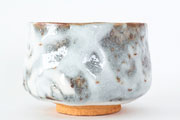
Hagi ware (called Hagi yaki in Japanese) is a form of porcelain produced mainly in the city of Hagi in Yamaguchi prefecture. Hagi ware is rarely decorated, remaining as simple as possible to make the most of the features of the clay. This simplici…
View more
-
Tsugaru lacquerware Tsugaru nuri
- Lacquerware
- Aomori

Tsugaru lacquerware (called tsugaru nuri in Japanese) is produced around the city of Hirosaki in Aomori prefecture. Lacquerware has been produced in this region since the middle of the Edo period (1603-1868), but it began to be called Tsugaru lacq…
View more
-
Echizen traditional Japanese paper Echizen washi
- Traditional Japanese paper
- Fukui
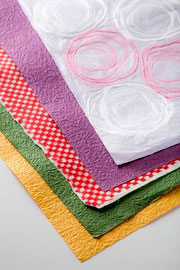
Echizen washi is a Japanese traditional paper made in the basin of the Okafuto river of the Echizen region, Fukui prefecture. Washi is made mostly from the inner bark fibers of plants such as paper mulberry, paperbush, and ganpi. Echizen washi fea…
View more
-
Iwayado traditional chest Iwayado tansu
- Wood, bamboo crafts
- Iwate

Iwayado tansu is a traditional woodwork made in the cities of Oshu and Morioka, Iwate prefecture. Tansu means chest of drawers. In addition to clothing or organization chests, daily use items like tea cabinets, book shelves, and low tables are mad…
View more
-
Takaoka copperware Takaoka doki
- Metal works
- Toyama
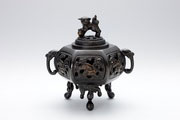
Takaoka copperware (called Takaoka doki in Japanese) is a type of copperware produced in the area around the city of Takaoka in Toyama prefecture. The various products range from small items such as indoor ornaments, Buddhist tools, and vases to l…
View more
-
Inami wood carvings Inami chokoku
- Wood, bamboo crafts
- Toyama
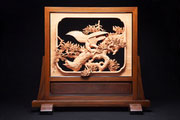
Inami woodcarvings (called Inami chokoku in Japanese) are produced in the city of Nanto, Toyama prefecture mainly in the form of transoms*, decorative objects, and single-leaf screens**. They are usually made of Japanese camphor, paulownia, or zel…
View more
-
Echizen lacquerware Echizen shikki
- Lacquerware
- Fukui
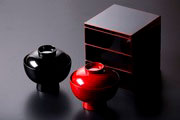
Echizen lacquerware (called Echizen shikki in Japanese) is produced in the area around the city of Sabae in Fukui prefecture. Lacquer is at the center of life in the Echizen district of Sabae, which is known as the city of manufacturing. The notab…
View more
-
Joboji lacquerware Joboji nuri
- Lacquerware
- Iwate
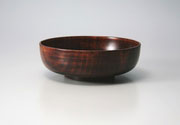
Joboji lacquerware (called Joboji nuri in Japanese) is produced in the town of Joboji in Iwate prefecture. More than 98% of the lacquer used in Japan is imported from China or other countries. The Joboji area is known as the leading producer of do…
View more
-
Hidehira lacquerware Hidehira nuri
- Lacquerware
- Iwate
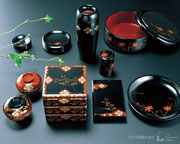
Hidehira lacquerware (called Hidehira-nuri in Japanese) is produced in the area around the town of Hiraizumi, in Iwate prefecture. The defining feature of Hidehira lacquerware is the use of gold leaf produced in the area around Hiraizumi, which re…
View more
-
Sekishu traditional Japanese paper Sekishu washi
- Traditional Japanese paper
- Shimane
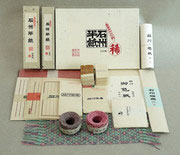
Sekishu washi is a traditional Japanese paper produced in the Iwami region of Shimane prefecture. As an ancient craft, it has a history of around 1300 years. The name Sekishu is found in writings from the Heian period (794-1185). There is also a s…
View more
-
Akama inkstone Akama suzuri
- Writing tools
- Yamaguchi
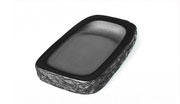
Akama inkstone (called Akama suzuri in Japanese) is produced around the cities of Shimonoseki and Ube in Yamaguchi prefecture. A type of stone called akama, an ideal material for producing the inkstones, is used for Akama inkstone. Therefore this …
View more
-
Echizen ware Echizen yaki
- Ceramic
- Fukui
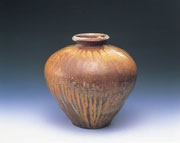
Echizen ware (called Echizen yaki in Japanese) is a type of pottery produced in the town of Echizen, Fukui prefecture. This traditional handicraft comes from one of the Six Ancient Kilns of Japan which along with Bizen, Tamba, Tokoname, Seto, and …
View more
-
Sakai cutlery Sakai uchihamono
- Metal works
- Osaka
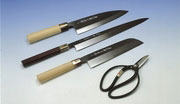
Sakai traditional blades are hammer-forged knives produced in the cities of Osaka and Sakai, Osaka prefecture. To achieve both strength and cutting quality, this craft is made by combining soft iron and steel. This craft is forged to have a sharp…
View more
-
Takaoka lacquerware Takaoka shikki
- Lacquerware
- Toyama
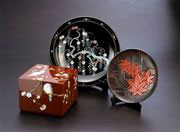
Takaoka lacquerware (called Takaoka shikki in Japanese) is produced in the area around the city of Takaoka, in Toyama prefecture. A defining feature of this lacquerware is the wide range of techniques and styles. Aogai-nuri is a technique that use…
View more
-
Unshu abacus Unshu soroban
- Writing tools
- Shimane
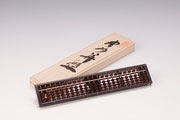
Unshu abacuses (called Unshu soroban in Japanese) are produced in the town of Okuizumo, Shimane prefecture. Japanese abacuses are traditional tools that use columns lined with beads that are quickly moved with the fingers to do calculations. They …
View more
-
Wakasa lacquerware Wakasa nuri
- Lacquerware
- Fukui

Wakasa lacquerware (called Wakasa-nuri in Japanese) is produced in the area around the city of Obama, Fukui prefecture. It is said to have originated in the early Edo period (1603-1868) when a craftsman serving the Obama domain (now the city of Ob…
View more
-
Ouchi lacquerware Ouchi nuri
- Lacquerware
- Yamaguchi
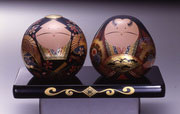
Ouchi lacquerware (called Ouchi nuri in Japanese) is produced around the city of Yamaguchi, in Yamaguchi prefecture. This craft emerged under the Ouchi clan, which boasted significant influence and power in the region during the Muromachi period (…
View more
-
Echizen cutlery Echizen uchihamono
- Metal works
- Fukui
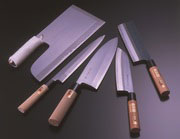
Echizen cutlery (called Echizen uchihamono in Japanese) is produced around the city of Echizen, Fukui prefecture. A double layering technique is used for knives and a rotated steel joining technique for sickles. Double layering is a forging method…
View more
-
Osaka naniwa pewterware Osaka naniwa suzuki
- Metal works
- Osaka
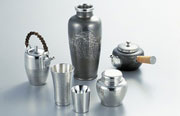
Osaka naniwa pewterware (called Osaka naniwa suzuki in Japanese) is a metalwork produced in and around the city of Osaka, Osaka prefecture. In the past, tin mined in Japan was used, but today it is imported mainly from Thailand and Indonesia. This…
View more
-
Iwami ware Iwami yaki
- Ceramic
- Shimane
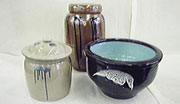
Iwami ware (called Iwami yaki) is a type of pottery produced around the city of Gotsu, Shimane prefecture. Iwami ware is strong, has low water absorbency and is resistant to salt, acid, and alkali which makes it suitable for storing pickled plums …
View more
-
Osaka Buddhist altar Osaka butsudan
- Household Buddhist altars
- Osaka
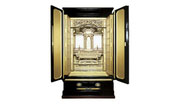
Osaka Buddhist altars (called Osaka butsudan in Japanese) are produced in the cities of Osaka, Yao, Higashiosaka, Sakai, and Kishiwada in Osaka prefecture. Along with the standard lacquer-painted, gold-leafed altars, this region is also known for …
View more
-
Echu traditional Japanese paper Echu washi
- Traditional Japanese paper
- Toyama
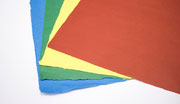
Etchu washi is traditional Japanese paper made in Asahi, Yatsuo, and Taira in Toyama prefecture. Each production area makes their own type of washi which are called Gokayama washi, Yatsuo washi, and Birudan washi. This craft has slight regional va…
View more
-
Osaka carved wooden panel Osaka ranma
- Wood, bamboo crafts
- Osaka

Osaka Transoms (called Osaka Ranma in Japanese) are transoms produced in and around the cities of Osaka, Kishiwada, and Suita in Osaka prefecture. In a Japanese-style house, transoms are wooden panels attached between the ceilings and lintels of t…
View more
-
Echizen traditional chest Echizen tansu
- Wood, bamboo crafts
- Fukui
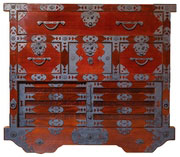
Echizen Tansu are lacquer coated chests of drawers made around Echizen City and Sabae City of Fukui Prefecture. They are mainly made of Japanese zelkova and paulownia, and decorated with iron fittings and lacquer. Japanese zelkova is a hard wood w…
View more
-
Osaka karaki wood joinery Osaka karaki sashimono
- Wood, bamboo crafts
- Osaka
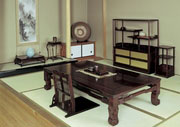
Osaka Karaki Wood Joinery, called Osaka Karaki Sashimono in Japanese, are wooden articles manufactured in several cities of Osaka Prefecture. Karaki is wood from trees mainly grown in Southeast Asia, and include rosewood, ebony, Chinese quince, an…
View more
-
Wakasa agate craft Wakasa meno zaiku
- Semiprecious stone craftwork
- Fukui

Wakasa Agate Craft (Wakasa Meno Zaiku in Japanese) is agate craftwork produced around the city of Obama, Fukui prefecture. Agate has been appreciated from olden times as one of the seven treasures that decorated the sublime Buddhist paradise ment…
View more
-
Osaka bamboo screens Osaka kongo sudare
- Wood, bamboo crafts
- Osaka
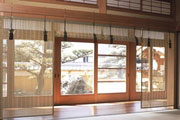
Osaka Kongo Sudare are bamboo blinds produced in the cities of Tondabayashi and Kawachi-Nagano in Osaka Prefecture. Tondabayashi City lies at the foot of Mt. Kongo, the highest mountain in Osaka, and good quality Japanese timber bamboo growing nat…
View more
-
Osaka-senshu traditional paulownia chest Osaka senshu kiri tansu
- Wood, bamboo crafts
- Osaka
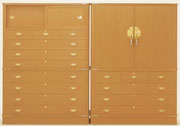
Osaka Senshu Kiri Tansu are wooden chests of drawers made in and around Kishiwada City and Sakai City, Osaka Prefecture. They are made from Paulownia wood, much appreciated for its durability, excellent moisture barrier properties and fire resista…
View more
-
Shogawa woodcraft Shogawa hikimono kiji
- Industrial art materials and tools
- Toyama
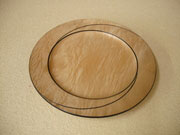
Shogawa woodcrafts are mostly woodcraft articles such as bowls or trays made in a wide area of the Toyama Prefecture including the city of Takaoka and the city of Tonami. Shogawa woodcrafts were designated as a traditional craft by the Ministry of…
View more

































































































































































































































































































